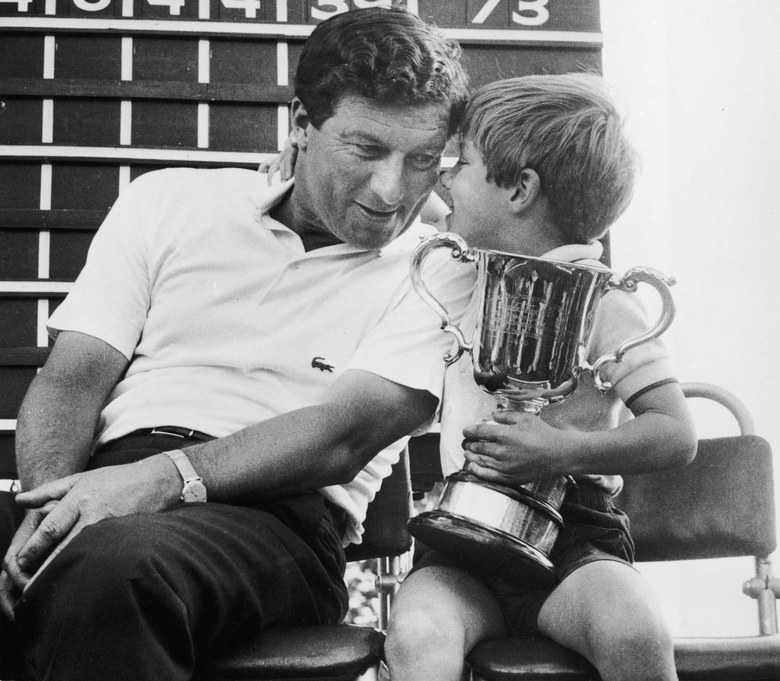Central Press
By Jerry Tarde
Peter Thomson, 88, died this week and took common sense with him. He was one of my early counselors in the game, always reliable for straight advice steeped in erudition and experience. My opening line with him was always the same cliché: “Between the two of us, Peter, we’ve won five British Opens.”
He joined the Golf Digest staff as a contributing editor in 1986. At the time, I wrote in the editor’s letter: “Thomson is best known to America as a player, but internationally he is recognised as an architect, writer, administrator and statesman. He once ran for Parliament in his native Australia and was narrowly defeated. He is credited with founding the Far Eastern tournament circuit, ranging from India to Japan. He is unique in the sport, a reader of hardcover books, kind of an outdoor intellectual.” After winning a tour event, it would be common to see him accept the trophy, then go into the press tent and roll a piece of paper into a typewriter carriage, and proceed to rap out a report on the final round as the golf correspondent to far-flung newspapers.
American golfers got a dose of his playing talent when he returned to competitive golf with the Senior PGA Tour and promptly won 11 tournaments. I remember him doing a clinic for our editorial staff once when someone asked the unfortunate question, “How far do you hit your 7-iron?” Peter silently replied by dropping three balls next to each other on the practice ground: one in a good lie, the second he stepped on, and a third on a tuft of rough. Making identical swings, he hit the 7-iron what looked to be 140, 150 and 160 yards. “Next question,” he said.
Over lunch at our offices in Connecticut, I once asked him about Jack Nicklaus’ design work. “Nicklaus courses are like Jack himself—grim and humorless, with sharp edges,” he said.
In his first column for Golf Digest (February 1987), he wrote: “When I first took to journalism, my kind but stern mentor laid down the principle that if my grandmother couldn’t understand what I was writing about, it was a lousy piece of composition. I’ve come to carry this along into golf architecture. If my grandma can’t play it, it has to be a lousy course.”
Peter told wonderful first-hand stories like the time USGA Executive Secretary Joseph C. Dey Jr. approached on the first tee at Oakmont in the 1953 U.S. Open: “Joe came up to our threesome and stood before the legendary Ben Hogan with a clear enough message: ‘Ben, your group was too slow yesterday. We would like you to speed it up today,’ followed by the unfailing courtesy for which Joe was world renowned, ‘if you don’t mind.’“ ‘If you are thinking of giving me a two-stroke penalty, then give it to me now so I know where I stand,’ Hogan said.
“‘There’s no need for that,’ Joe said. ‘We just want you to play faster.’ And looking at Sam Urzetta and me, he added, ‘That goes for each of you.’ ” (It was the year Hogan won his fourth U.S. Open.)
We have many memories of the great man always dressed in blue blazer and gray slacks with an R&A necktie. I was walking to the course with Executive Editor Mike O’Malley one morning during the 1996 Open at Royal Lytham & St. Annes when we heard his familiar voice from behind, slowed down to enjoy his company, and Mike asked him what his favorite Open venue was. A long pause, several steps, and finally: “This one, Lytham,” said Peter, who won his five from 1954-’65 at Birkdale, St. Andrews, Hoylake, Lytham and Birkdale.
The last time I saw him was at the R&A Members Dinner in 2015 at the Old Course. After the entrée and before dessert, it was announced that Tom Watson was about to play up the 18th fairway in the gloaming of his last competitive round at the Open Championship. We all respectfully filed out to stand on the first tee and watch Old Tom finish. Peter was standing nearby. I said to myself, Among the three of us, we’ve won 10 British Opens.









